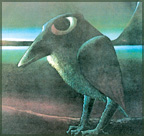Tisnikar: The painter of deathART: Yugoslav born Joze Tisnikar is perhaps the eeriest painter I have come across. Not so much for his art but the concept with which he had painted through the eye of a pathologist. Tisnikar had worked for over 25 years in the night shift in the pathology department of the main hospital in Slovenj Gradec, a picturesque town in Slovene. It nestles in the foothills of the Alps and ten kilometres from the Yugoslav-Austrian border. Tisnikar witnessed the arrival of the dead into the autopsy room on an endless conveyor belt. He watched with care and precision, observing each and every details of the dead and worked on the corpses throughout the night until the wee hours of the morning by which time he was ready to sleep. Having done the postmortem, he delivered the bodies to their families.
After a short morning nap and a fresh bath to rid the smell of death around him, Tisnikar picked his brushes and resurrected the dead. He used the identical colours and the expressions that he found on them. Some died prematurely, some of incurable diseases while others of excess alcohol and some suicides. They never resembled the way they arrived as Tisnikar gave a different twist in his extraordinary paintings. To the best of his ability, he imagined them few hours before they died and the ugly hand of death that distorted them. So, he painted on, giving the resemblance as though they had arrived from the other world. In creating a lasting memory of the departed, he supplied us the answer to a riddle as old as the human race: What remains of man when he dies?
He had reconciled to himself that man ceases to exist the moment he dies. Tisnikar himself was the moving story of the fall and rise of man: the uncertain beginning of a disintegrated personality and alcoholic. This is what he had experienced and saw for 25 years in the morbid nights on a cold slab as he dissected the mortal remains. Ironically, Tisnikar the pathologist/painter what he had seen because he had a nervous breakdown and was treated for alcohol. He had attempted suicide on several occasions. But from all these calamities, Tisnikar rose to be a powerful and original painter. In his triumph over self, he created man's last moments as a dedicated chronicler. A wondrous world of the resurrected dead. Many of Tisnikar's admirers and well wishers have rallied around him and spurred him to be the painter that he is today. They helped him when he seemed to be on the brink of disaster both as a pathologist and painter. Tisnikar's reputation as a painter may not be large because his works were not widely published. Painting by night when the world was dead and eerie shadows outside his window, may also have influenced Tisnikar in the colours he used. Depending mostly on dark blues and black, his figures stared out in the horror of death. But most of the time he used the stunning shades of blues to relieve the black as he focussed on the painting. He was a veritable avalanches sweeping over niches of the dead. Tisnikar, always muttered to any one he met; 'You obviously don't like my paintings. No one does.' Blood on snowOnce awhile, he had created the stark difference of colours such as blood on snow. There had been instances when brutally killed bodies with dripping blood are towed towards his pathological department in the snow. Such instances are quickly captured on canvas before the impact wears off or before the bloody trails are covered by more snow. When bodies are ushered during the day, Tisnikar would notice the ravers out side his window. He would watch the greed in their eyes and the urgency to devour stuff he would throw out. In the period spanning over 25 years Tisnikar painted over 400 pictures. He had been discontented with life which reflected in the paintings. Because of this reason, psychologically, the pictures irritated him and in fits of depression he destroyed most of them. He was aware he was not the painter that art lovers would flock to see or even buy one. Often he would trample his pictures but on many occasions the Head of the Hospital, Dr. Stane Strand would intervene and rescue most of them. It was because of his interventions that we are able to see a number of Tisnikar's works that had been salvaged and exhibited in Yugoslavia and other places. Though a brilliant pathologist, Tisnikar had only few lessons in art. Without training, he had perfected his own style of painting. He modelled himself on his own impetus to record man's last moments on earth. Disenchanted with life and loneliness for many years, he identified his own distress with the suffering of the loved ones of the deceased. From the depths of his loneliness, he gave rise to an ancient Bibilical story of a man departing this earth: 'Even the words of a man speaks, leave some trace, to say nothing of the man' That was the legend of Joze Tisnikar, the painter of death. |
||
|
.................................. |








